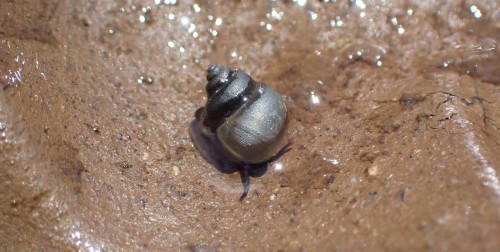LATEST NEWS
Entura rediscovers snail species thought likely to be extinct at Tasmania’s Great Lake
March 17, 2022
Entura’s environment team have rediscovered a species of freshwater snail thought likely to be extinct during a survey at Tasmania’s yingina/Great Lake.
The Beddomeia tumida, a tiny snail measuring around 4mm, was found as part of ongoing conservation monitoring of the lake, funded by Hydro Tasmania. Located in the Central Plateau, it is the first time the live snail has been seen or recorded in the areas since the 1900s.
The team were initially searching for another previously thought to be extinct snail species, the Great Lake giant freshwater limpet (Ancylastrum cumingianus), which they had rediscovered during an aquatic invertebrate survey when the lake was at a historic low.
Returning to the now refilled lake in late 2021, the team attached old roof tiles sourced from a tip to ropes and buoys. The tiles were dropped at various depths (2-10 metres) to the lake floor in the hope they would become inhabited by bottom-dwelling species, such as the limpet.
In January this year, when the team retrieved the tiles, they found not only the presence of limpets in low abundance, but also three specimens of Beddomeia tumida (Great Lake freshwater snail). Subsequent surveys have recorded further specimens of both snails on other tiles, so far in low numbers, all located in the north basin near Reynolds Island.
The species were identified with the help of Dr Karen Richards, senior zoologist and aquatic mollusc expert at the Threatened Species Section, Department of Natural Resources and Environment Tasmania. Beddomeia tumida is listed as endangered on the Tasmanian Threatened Species Protection Act 1995 (TSPA), and critically endangered but possibly extinct on the IUCN red list.
“It’s a significant find because we now know it still exists,” said Entura’s Water Quality Consultant Kevin Macfarlane, who led the survey. “It could have been re-listed within days or months as extinct if we hadn’t found it. Once we get an idea of the population size it could potentially be listed as not critically endangered, and hopefully we find that it’s abundant.”
“As Beddomeia species are not present at locations of reduced water quality, this tells us that the water quality is very good, and the habitat is very good,” he added. “It’s not common for people in the sciences to discover new or extinct species, so it’s a great position to be in.”
The Hydro Tasmania-funded surveys have been ongoing since the 2000s, during which six undescribed species of freshwater snail have been identified. These were found during the surveys conducted in 2015 and 2016, when the lake was at its second lowest recorded level.
“2015-16 was followed by a boom in populations, such as the native lake fish, once the water levels rose again,” said Kevin. “We’re trying to understand the health of the lake, and it appears to have resilient inhabitants.”
“We’ve discovered not only undescribed snails in Great Lake, but numerous phreatoicids, which are small crustaceans, and an aquatic plant called a charophyte. We’ve also uncovered previously unknown sponges in some of the other Central Highlands Lakes and found animals in other lakes where they weren’t known to exist.”
Great Lake was the first source of water for Hydro Tasmania. It initially fed Waddamana Power Station, which was run by the Tasmanian Government-owned Hydroelectric Department from 1916 until 1964, and replaced by Poatina Power Station in 1966.
Speaking of the importance of ongoing surveys, Kevin said: “When the lake was flooded in 1901, there was no baseline survey undertaken of what might be affected as we do these days, so the efforts today are focused on clawing back as much of that missing knowledge as we can. The more knowledge we gain on the flora and fauna of the lake, the greater chance we have to protect them.”
The find is just the latest for Entura’s environment team, who recently spotted a native herb which resembles clover called Glycine latrobeana at Lagoon of Islands, also on the Central Plateau. The clover had not been seen in the area for over 20 years, and is listed as vulnerable on the Commonwealth Environment Protection and Biodiversity Conservation Act 1999 and the Tasmanian Threatened Species Protection Act 1995.
“It’s really hard to find because it’s so small and very palatable,” said Environment Team Leader, Raymond Brereton. “It gets browsed a lot by wallabies and wombats which means you hardly get to see it in flower, so this was an exciting find.”
“Our team often find that if you really put in the effort to look for these species of threatened flora and fauna, you’ll find them, and fortunately, that’s often how it turns out for us.”






